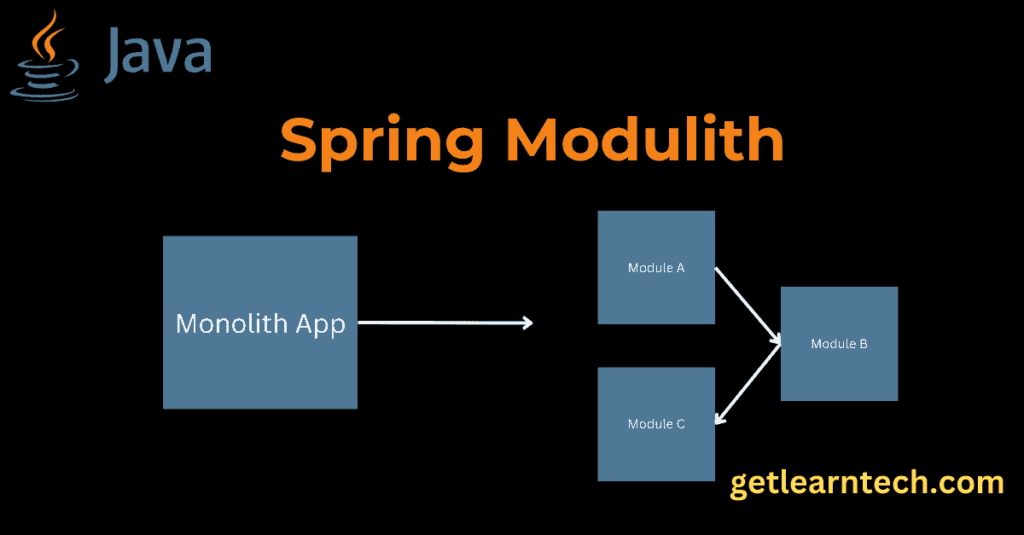Spring Modulith is an emerging architectural approach designed to enhance the modularity of Spring-based applications. It leverages the robust capabilities of Spring Boot and Spring Framework to create modular, maintainable, and scalable applications. This guide will explore the concept of Spring Modulith, its benefits, and provide relevant examples to illustrate its application.

Table of Contents
What is a Spring Modulith?
A Spring Modulith is a structured approach to building Spring Boot applications where the application is divided into distinct, loosely-coupled modules. Each module encapsulates a specific piece of functionality and can be developed, tested, and maintained independently. Unlike a monolithic architecture where all components are tightly coupled, or a microservices architecture where services are completely independent and communicate over a network, a modulith strikes a balance by promoting modularity within a single application.
Key Features of Spring Modulith
- Modularity: Each module represents a specific business capability or domain area.
- Encapsulation: Modules encapsulate their implementation details and expose only necessary interfaces.
- Loose Coupling: Modules interact with each other through well-defined interfaces, reducing dependencies.
- Scalability: Modules can be scaled independently based on their load and performance requirements.
- Maintainability: The separation of concerns makes it easier to maintain and evolve the application.
Benefits of Spring Modulith
- Improved Maintainability: By breaking down the application into smaller, manageable modules, developers can focus on specific parts without affecting the entire system.
- Enhanced Testability: Modules can be tested in isolation, leading to more robust and reliable code.
- Parallel Development: Teams can work on different modules concurrently, speeding up the development process.
- Flexibility: Modules can be replaced or upgraded independently, facilitating easier updates and technology adoption.
Example of a Spring Modulith Application
Let’s consider an e-commerce application as an example. This application might include the following modules:
- User Management Module: Handles user registration, authentication, and profile management.
- Product Catalog Module: Manages product listings, categories, and search functionality.
- Order Processing Module: Takes care of order placement, tracking, and history.
- Payment Module: Manages payment processing and transactions.
- Notification Module: Handles email and SMS notifications.
Implementing a Spring Modulith
1. Setting Up the Project
First, create a new Spring Boot project using Spring Initializr or your preferred method. Include dependencies like Spring Web, Spring Data JPA, and any other necessary modules.
<dependency>
<groupId>org.springframework.boot</groupId>
<artifactId>spring-boot-starter-web</artifactId>
</dependency>
<dependency>
<groupId>org.springframework.boot</groupId>
<artifactId>spring-boot-starter-data-jpa</artifactId>
</dependency>
2. Defining Modules
Organize your project structure to reflect different modules. For instance:
src/main/java/com/example/ecommerce
│
├── user
│ ├── UserController.java
│ ├── UserService.java
│ ├── UserRepository.java
│ └── User.java
│
├── product
│ ├── ProductController.java
│ ├── ProductService.java
│ ├── ProductRepository.java
│ └── Product.java
│
├── order
│ ├── OrderController.java
│ ├── OrderService.java
│ ├── OrderRepository.java
│ └── Order.java
│
├── payment
│ ├── PaymentController.java
│ ├── PaymentService.java
│ ├── PaymentRepository.java
│ └── Payment.java
│
└── notification
├── NotificationService.java
└── EmailSender.java
3. Encapsulating Module Logic
Ensure each module encapsulates its logic and exposes only necessary interfaces. For example, the UserService in the User Management module:
package com.example.ecommerce.user;
import org.springframework.stereotype.Service;
import java.util.List;
@Service
public class UserService {
private final UserRepository userRepository;
public UserService(UserRepository userRepository) {
this.userRepository = userRepository;
}
public User registerUser(User user) {
return userRepository.save(user);
}
public User getUserById(Long id) {
return userRepository.findById(id).orElse(null);
}
public List<User> getAllUsers() {
return userRepository.findAll();
}
}
4. Communication Between Modules
Modules should communicate through well-defined interfaces or application events. For instance, the Order Processing module might need to interact with the User Management module to retrieve user information:
package com.example.ecommerce.order;
import com.example.ecommerce.user.UserService;
import org.springframework.stereotype.Service;
@Service
public class OrderService {
private final OrderRepository orderRepository;
private final UserService userService;
public OrderService(OrderRepository orderRepository, UserService userService) {
this.orderRepository = orderRepository;
this.userService = userService;
}
public Order placeOrder(Long userId, Order order) {
var user = userService.getUserById(userId);
if (user != null) {
order.setUser(user);
return orderRepository.save(order);
} else {
throw new IllegalArgumentException("User not found");
}
}
}
5. Using Application Events
Spring’s event system can be used to decouple modules further. For example, the Notification module can listen for order placement events to send notifications:
package com.example.ecommerce.notification;
import com.example.ecommerce.order.OrderPlacedEvent;
import org.springframework.context.event.EventListener;
import org.springframework.stereotype.Service;
@Service
public class NotificationService {
@EventListener
public void handleOrderPlaced(OrderPlacedEvent event) {
// Logic to send notification
}
}
6. Configuration and Bootstrapping
Each module can have its configuration, and the main application class will bootstrap the entire application:
package com.example.ecommerce;
import org.springframework.boot.SpringApplication;
import org.springframework.boot.autoconfigure.SpringBootApplication;
@SpringBootApplication
public class EcommerceApplication {
public static void main(String[] args) {
SpringApplication.run(EcommerceApplication.class, args);
}
}
Conclusion
Spring Modulith provides a powerful way to build modular, maintainable, and scalable applications within the Spring ecosystem. By dividing your application into well-defined modules, you can achieve a balance between the simplicity of a monolith and the flexibility of microservices. This approach not only improves maintainability and testability but also allows for parallel development and easier upgrades. With Spring Modulith, you can harness the full potential of modular architecture in your Spring Boot applications.
If you are preparing for Java String interviews you can checkout here.

